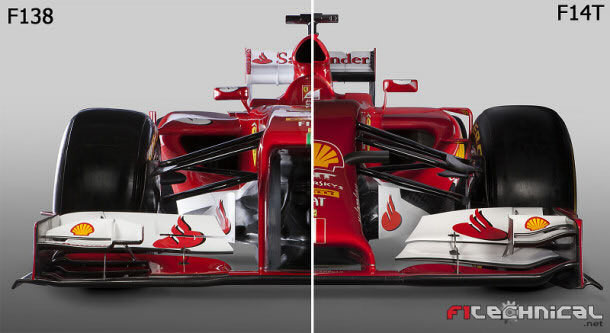2014 Nose Cone Design
After 2014 gigantic rule change, maybe the biggest ever in Formula 1 history, the key feature of most of the 2014 cars will be an odd shaped anteater nose. And all of that because FIA, issuing new rules, as usually didn't think it trough. Rules were written in good faith to improve a safety of the cars in case of 90 degree T-bone crashes and to prevent cars launching off the back of other cars - if a following car was to hit the rear tire of a car in front then it would get kicked up in the air, but a lower nose would prevent that. These strange noses are likely to be a talking point in the first part of the season as fans get used to their odd design.
Clearly a low nose tip would be best introduced as a part of rules that include lower chassis all the way from the nose to the cockpit. However, the teams opposed this idea because this would mean all new aerodynamics and all new suspension, which on top of other plethora of regulatory changes was a step too far. The regulations subsequently lowered the nose to a specific 185mm height and the front bulkhead 100mm down from 625mm to a 525mm maximum height. This compromise saved the teams an expensive redesign, but left opportunities for exploiting the intention of the rule for aerodynamic benefit.
Nose cone is highly influential in the airflow all the way back and along the car, and is a limiting factor in directing air passing under the nose and under the floor. The nose tip is first point of the airflow hitting the car, before the flow passes back along the car. Since the Tyrrell 019 first introduced high nose, teams has progressively raised the nose to the maximum permissible height, the aero gain was so great that the high CoG and unfavorable front suspension geometry are compromised in favor of better lap time.
With new regulations and nose tip now so low and limiting a quantity of the air passing under the car, teams have to look how to improve on that and in what way to allow more air under the car.
Picture By Steven De Groote from F1Technical forum
The thing with the nose is that you have to pin it down at one point because it decides a lot of the philosophy behind it. Shape of nose cone is also highly influenced by the need to pass a crash test and mount the front wing to the chassis. A complicated set of requirements define the chassis height at certain points, and the height and minimum dimensions of the nose tip. The nose must meet a minimum nose tip height. This means that the area 50mm behind the actual tip must be centered at 185mm above the cars reference plane, additionally this cross section must not be lower than 135mm or 10mm above the front wing, or above 300mm. To comply with Article 15.4.3 of the Technical Regulations, the cross section of the nose, 50mm behind the tip, must be larger than 9000mm² which equates to a 97X97mm square or 107mm diameter circle, rectangle of 9 by 10 centimeters, or one that is 15cm wide and just 6cm high or more or less any shape with 9000mm², which mean that the actual shape is relatively free within these parameters. Also, the nose must not be higher than a diagonal line passing from 300mm height at the nose tip and a 625mm at the front bulkhead. This prevents noses being arched upwards excessively to aid airflow under the car. In terms of length the nose can not be shorter than front wing centre section and can extend forwards beyond the front wing. Also, rules demand that nose cone must be a single open section. This was to prevent the slotted noses Ferrari introduced in 2008.
This rules makes teams think how to design nose shape as much as possible out of the way of the airflow passing under the raised chassis, or how to make it as small obstruction as possible.
Not everyone appreciates the look of the 2014 cars, but as the covers came off each of the new machines in Jerez, no one could doubt the diversity on display at the front of the cars. All the shapes are aimed at getting as much air under the car as possible for aerodynamic reasons while satisfying the requirement for a lower nose. There have been some interesting ideas and different interpretations of the technical regulations in the nose section of the car that we've seen in the pictures - the Ferrari is totally different and is quite nice actually. The reason for that is that the nose rules allow quite a lot geometrical freedom and you go off exploring that freedom.
Some are clearly more aesthetically-pleasing than others. I'll let you make your own minds up about which ones you like, but it’s refreshing to see how each team has interpreted the rule book in a different way. So far, the ‘finger’ nose seems to be particularly popular, but even those show considerable variety - just look at the front of the Force India compared to the Torro Rosso.
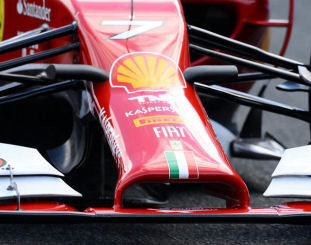 |
Ferrari’s solution is a sculpted though significant step down from the front bulkhead leading to a relatively wide and flat nose. The virtually none existent connecting pylons are shaped in such way to enlarge the airflow passage beyond the narrow opening created between the mainplane and nose tip. Retaining the chassis height also enables Ferrari to retain the pull rod front suspension used since the F2012. Ferrari and Mercedes have clearly chosen to have a wide nose, creating a fairly flat top (with Ferrari's more rounded) of the nose, rather than a bulge that sticks out ahead of the front wing. The proximity of this noses to front wing center neutral plate also creates a venturi with the front wing itself, attempting to speed up airflow underneath the nose cone, and this will reduce pressure and generate downforce. The rounded edges of the upper side of the nose suggest that Ferrari and Merc are trying to get air flow from higher pressure areas on upper side of the nose to lover pressure area underneath the nose, something that is beneficial as teams are still aiming to get as much air as possible towards the floor to help the diffuser. Ferrari have retained a very high monocoque that only slightly tapers down at the front to meet the regulations. |
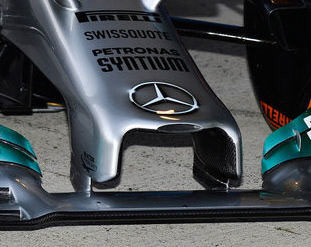 |
|
 |
Caterham CT05 has gone in different way than any other team. Narrow nose tip is "growing" like a finger from wider upper nose area with edges shaped in the way to help push and channel the air below the chassis area and below the floor. Front wing support pylons are fitted to nose tip itself, and that is the only team till today (01. February 2014) with this solution. Narrow-spaced front wing pylons can limit their use as aero devices. Here is obvious that the two demands for the nose are split into two different nose sections: an upper nose for aero and the lower nose for legality and crash test. Narrow nose tip puts the minimum cross section low down to aid of airflow to the back of the car. |
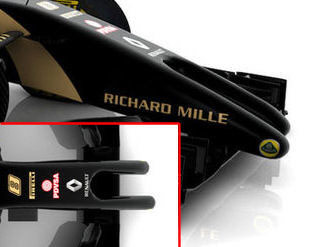 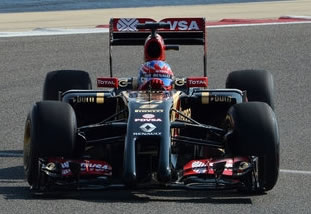 |
This is a solution that most people will scratch their heads on their understanding of the 2014 nose tip regulations. The car features a very clever solution and different approach to the new safety regulations regarding the nose of the car. Instead of the single narrow appendage to lower the tip of the nose, Lotus has a two-pronged solution with a gap to allow airflow to the reach the floor of the car. Only Lotus know the benefit they gain from this design but I’m happy that at least one team has created very different solution. Two protruding pillars - essentially a double nose - slope down over the front wing, and form both the crash structures, and the front wing mountings. Curiously these prongs are of different length, with the right prong longer than the left. What Lotus has done is to create a mandatory nose tip, in terms of cross section and height, but with just one, right prong, which is at least 90mm wide in order to meet the requirements of the regulations. But in order to avoid the twin prong design being considered as having more than one nose tip (explicitly excluded in the rules) the left prong is shorter to avoid being in the same plane as the right hand prong tip. |
 |
Typically, Red Bull found their own solution to the new nose regulations. The RB10 features a slightly neater take on the 'anteater' style noses on most cars this year. Technical director Adrian Newey is not a fan of the regulation, describing the noses as "an awful shame". The mandatory low nose tip is made up of a rectangular section, but being a narrower and vertical cross section than the rounder or squarer noses of other teams, Newey blended this section backwards into the underside of the upper nose, in teardrop profile and then bended the shape upwards. To be legal this area needs to be structural and form a part of the crash zone. Probable benefits of this design would be better performance in yaw, the shorter tail of the nose tip presenting less side area to the airflow. Also, this is an evolution of the 'S-duct' seen on last year's RB9. Air enters through ducts on the nose and underneath the chassis, passing through in the bulkhead area, and then exiting via a duct on the top of the chassis. This can reduce airflow separation that is byproducts of the low nose/stepped chassis combination. |
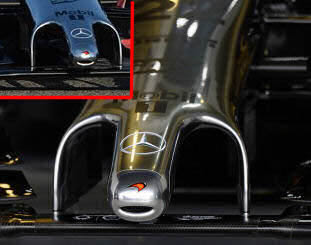 |
Another design solution used by McLaren, Force India, Scuderia Torro Rosso, Sauber, Williams and Marusia is to make the wedge shaped upper nose structural part which will support front wing. This may be a more complex design, as the crash structure needs to go from thin initial section to a far thicker section as the upper nose is impacted in the test, changing the decelerations with the change in cross section. This solution may well be heavier due to the complex shape. However this design does allow the front wing to be mounted via taller wider spaced pylons, giving some aerodynamics gains, to separate the front tire wake from the chassis and also create a low pressure area for some downforce on the central part of the front wing. McLaren MP4-29 was the first to release pictures of the actual car featuring its own variation on the 'drooping' nose design and this is their response to the sport's new rules. The car looks pretty tidy albeit with quite a lot of complexity on the front nose and wing assembly. Check here to learn about McLaren new and innovative rear suspension. Force India VYM07 also feature an prominent low and narrow 'anteater' style nose. Torro Rosso STR9 also features a sharp dip at the nose in a 'finger' or anteater style, with a prominent low and narrow nose to meet new regulations regarding the height of the front of the chassis. Torro Rosso appear to have gone further than most teams so far in keeping as much of the nose as high as possible before starting the narrower tip that complies with the new rules. Sauber C33 was the third Formula One car to be officially launched this year and again, another odd looking snout-like, very low front end to satisfy safety regulations regarding the height of the nose. Nose is similar in style to Williams and Force India with elongated hangers to the front wing. Williams FW36 and Marussia MR03, as all others anteater noses, has a low finger extension on the nose which protrudes from the characteristic wide section with underbody turning vanes. |
 |
|
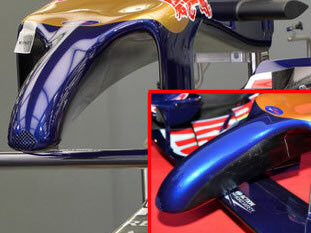 |
|
 |
|
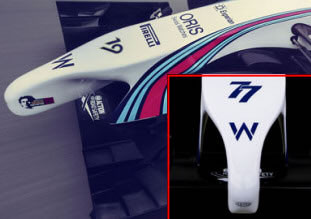 |
|
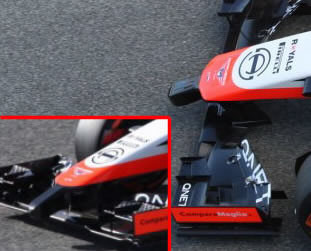 |
A lot of this designed shapes are only vanity plates, very thin and not structural "cover" for the crash structure. This vanity plates give a car nose definitive aerodynamic shape and is also easy to change in later development phase. Lets look at original Caterham CT05 nose cone and after vanity plates are "carefully" removed. You can see the difference in shape (green, non-structural and black, structural part of the nose cone).
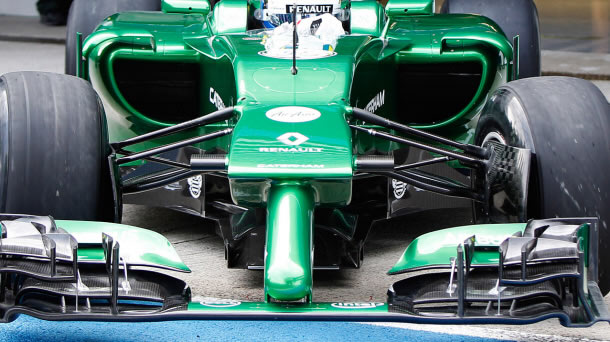
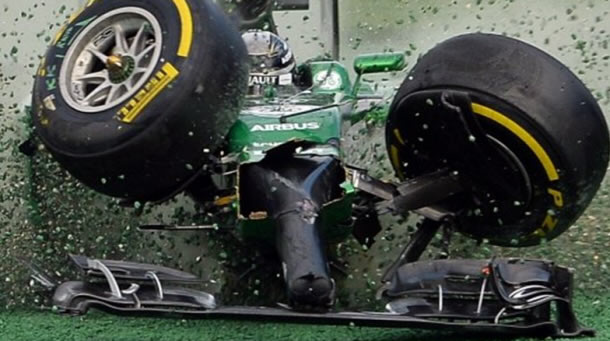
Kobayashi's accident at first race of 2014 season in Melbourne, first lap, first corner crash
To know more about nose cone design check my article here.
What few deny is they have produced a generation of cars which are unattractive, sapping the sport of aesthetic appeal. FIA's answer to this are some changes for next year in an attempt to push designers away from creating cars with unmistakably phallic interpretation of the regulations.
For 2015 new FIA regulations now require the following:
- The nose tip cross section remains the same at 9,000 mm2.
- The nose will be lowered further and must sit 135mm to 220mm above the floor
- The tip must be no wider than 140mm
- The nose must widen to a second cross section 150mm behind its tip, which must be no less than 20,000 mm2
- Again a maximum width is stated of 330mm at this second cross-section
- Both cross sections have to be symmetrical about the centre line
- Remaining length of the nose going back towards the chassis must have a tapering cross section
- The nose tip will have to start about mid-way along the front wing
What does this mean in real life? Now the rules specify two cross-sections, tapered between each other to avoid any strange shapes as the nose cone merges with the front bulkhead. The tip also has a maximum width requirement of 140mm. Teams will likely design an oval or rectangular nose tip that then merges in to the chassis.
The following drawing shows a very simple schematic of how a 2015 nose could look. There is still a nose, but it is shorter, a bit more stubby, and hopefully less unattractive than the some of the snouts on show this year.
Back to the top of the page

